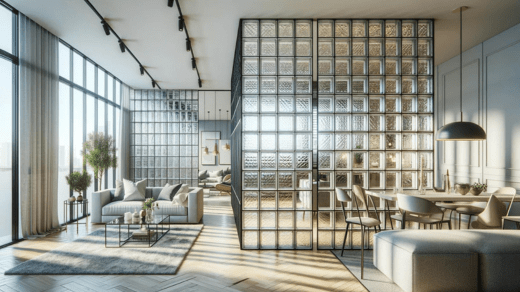Transform your home decor with stylish glass blocks. Learn how to incorporate trendy designs and elevate your space effortlessly.
Glass blocks have evolved from being mere structural components in buildings to becoming trendy elements in modern home decor. Their versatility, aesthetic appeal, and ability to allow light through while maintaining privacy make them a popular choice for interior designers and homeowners. If you’re aiming to add elegance and sophistication to your living space, consider incorporating glass blocks into your home decor. This article explores the evolution of glass blocks in home decor, offers tips on how to integrate them into your interior design, discusses top trends in using glass blocks in modern homes, highlights the benefits of installing glass blocks, showcases exciting DIY projects, and guides you on where to find the best glass blocks for sale.
The Evolution of Glass Blocks in Home Decor
Glass blocks have a rich history dating back to the early 1900s when they were primarily used as structural elements in commercial buildings and industrial spaces. Over time, their aesthetic appeal and functional benefits have made them a popular choice for residential interiors. Today, glass blocks come in various sizes, shapes, and patterns, allowing for endless design possibilities.
In modern home decor, glass blocks are no longer limited to bathrooms or exterior walls. They are creatively used in kitchens, living rooms, and even as decorative accents in furniture pieces. The evolution of glass blocks in home decor reflects a shift towards more open, light-filled spaces that seamlessly blend style and functionality.
The Rise of Glass Blocks in Contemporary Design
Contemporary interior designers have embraced glass block for their ability to create visual interest, add texture, and play with light and shadows. Whether used as room dividers, shower enclosures, or statement walls, glass blocks can elevate the overall look and feel of a space. Their timeless appeal and modern aesthetic make them a versatile choice for both classic and contemporary design schemes.
How to Incorporate Glass Block into Your Interior Design
When integrating glass blocks into your interior design, consider the overall style of your home and the effect you want to achieve. Here are some creative ways to incorporate glass blocks:
Room Dividers
Use glass blocks to create stylish and functional room dividers that allow light to pass through while defining separate areas in an open floor plan. Opt for frosted or textured glass blocks for added privacy without compromising on natural light.
Shower Enclosures
Transform your bathroom into a spa-like retreat by using glass blocks to create a sleek and modern shower enclosure. The translucent quality of glass blocks adds a touch of luxury and sophistication to any bathroom design.
Accent Walls
Make a statement in your living room or bedroom by incorporating a glass block accent wall. Choose a pattern or color that complements your existing decor to create a focal point that draws the eye and adds visual interest to the space.
Top Trends for Using Glass Blocks in Modern Homes
Glass block for sale have stood the test of time as a versatile and stylish design element. Here are some top trends for using glass blocks in modern homes:
Minimalist Design
Glass blocks are a perfect fit for minimalist interiors, where clean lines and simplicity reign supreme. Use glass blocks to create subtle partitions or accents that enhance the overall aesthetic of a minimalist space.
Industrial Chic
For an edgy and industrial look, consider incorporating glass blocks into your decor. Pair them with exposed brick walls, metal accents, and concrete floors to create a modern yet raw aesthetic that exudes urban charm.
Nature-Inspired Patterns
Bring the outdoors in by opting for glass blocks with nature-inspired patterns such as leaves, waves, or floral motifs. These decorative glass blocks can add a touch of whimsy and organic beauty to any room in your home.
Benefits of Installing Glass Blocks in Your Living Space
Glass blocks offer practical benefits beyond their aesthetic appeal, making them a practical choice for homeowners. Some key advantages of installing glass blocks in your living space include:
Natural Light
Glass blocks allow natural light to filter through while maintaining privacy, creating a bright and airy atmosphere in any room. This can help reduce the need for artificial lighting during the day, saving energy and lowering utility costs.
Sound Insulation
The thickness and density of glass blocks make them excellent sound insulators, helping to reduce noise transmission between rooms. This is especially beneficial in open-plan layouts or high-traffic areas where noise control is essential.
Easy Maintenance
Glass blocks are easy to clean and maintain, requiring only occasional wiping with a damp cloth to keep them looking like new. Unlike traditional windows or walls, glass blocks are resistant to mold, mildew, and water damage, making them a durable and long-lasting choice for any home.
DIY Projects: Enhancing Your Home with Glass Blocks
If you’re feeling creative and want to add a personal touch to your home decor, consider taking on some DIY projects using glass blocks. Here are a few ideas to get you started:
Glass Block Night Light
Create a charming night light using a single glass block fitted with LED strip lights. This project is simple yet effective and can add a warm and inviting glow to any room in your home.
Glass Block Table Lamp
Turn a set of glass blocks into a stylish table lamp by stacking them and adding a light fixture to the top. This DIY project is a great way to add ambient lighting and a touch of modern flair to your living space.
Glass Block Planter
Transform a glass block into a unique planter by filling it with soil and succulents. This creative project brings a touch of greenery indoors and adds a decorative element to your home decor.
Where to Find Glass Blocks for Sale
Now that you’re inspired to incorporate glass blocks into your home decor, it’s time to find the perfect glass blocks for sale. When shopping for glass blocks, consider factors such as size, pattern, and installation requirements to ensure they align with your design vision. Whether you’re looking to create a stunning accent wall, a functional room divider, or a stylish shower enclosure, there are plenty of options available to suit your needs.
In conclusion, glass blocks offer a unique and stylish way to enhance your home decor while providing practical benefits such as natural light, sound insulation, and easy maintenance. By exploring the various ways to incorporate glass blocks into your interior design, staying on top of the latest trends, and embarking on creative DIY projects, you can transform your living space into a chic and sophisticated haven. Elevate your home decor with trendy glass blocks today!
More Glass Block Details
Aspect Description History Glass blocks originated in the early 1900s as structural elements and have transitioned into popular decorative pieces for homes. Design Options Available in various sizes, shapes, and patterns, offering endless design possibilities for interior spaces. Usage in Home Decor Beyond bathrooms, glass blocks are now used in kitchens, living rooms, and as decorative accents, enhancing both style and functionality. Integration Ideas Can be incorporated as room dividers, shower enclosures, or accent walls, adding elegance and sophistication to any interior design. Trending Styles Minimalist design, industrial chic, and nature-inspired patterns are popular trends for using glass blocks in modern homes. Practical Benefits Provides natural light, sound insulation, and easy maintenance, making them a practical choice for homeowners seeking both aesthetics and functionality. DIY Projects DIY projects include creating night lights, table lamps, and planters using glass blocks, allowing for personalization and creativity in home decor. Shopping Guide When purchasing glass blocks, consider factors like size, pattern, and installation requirements to ensure they align with your design vision and functional needs.

